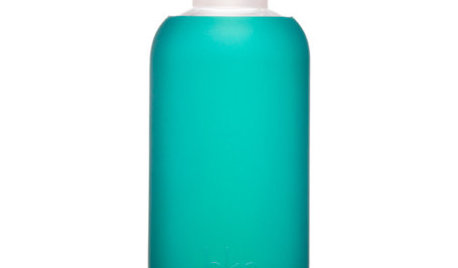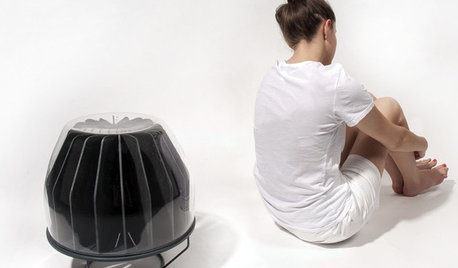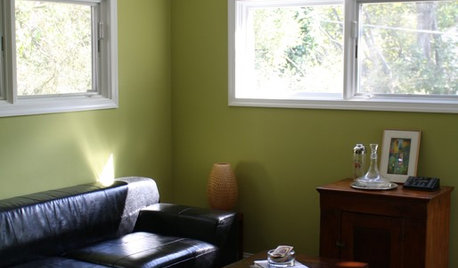Help for Ponytail Palm - Needs green on top
What can I do to get more green leaves on my ponytail? I used to water it about once a month but lately have watered it a little more. Occasionally I use Miracle Grow. Any help would be appreciated!
Here is a link that might be useful: Ponytail Palm
Comments (33)
rhizo_1 (North AL) zone 7
12 years agolast modified: 9 years agolinda, when a plant looks that bad on top, the first place you should investigate is the root/soil system.
tapla (mid-Michigan, USDA z5b-6a)
12 years agolast modified: 9 years agoHi, Linda. I agree. The dying and drooping (more than normal) leaves give the appearance of a plant that is suffering from problems in the root zone. It may be due to the combination of an overly water retentive soil and over-watering, or it could be due to an accumulation of salts from fertilizer solution and tap water in the soil. Under-watering is also a possibility. If you can examine and eliminate the possibility of insect infestation, particularly spider mites, and also the possibility you're under-watering, you can be almost certain that the problem is in that triangle of issues related to soil, watering habits, and salt levels in the soil .... and you can get some help here resolving that.
If you need help with how to check for insects or what to look for, or a list of steps you can take that will help isolate the likely cause, just ask.
When you water, are you watering in small sips or are you watering copiously so a significant volume of water moves through the soil and out the drain. If 'yes' to the last question, are you then removing the water from the collection saucer immediately and discarding it? Also, is the soil generally dry or very dry when you water, or still moist at finger-poking depth?
Al
Related Professionals
Carlisle Landscape Architects & Landscape Designers · Brentwood Landscape Architects & Landscape Designers · Clark Landscape Architects & Landscape Designers · Mount Wilson Landscape Architects & Landscape Designers · White Oak Landscape Architects & Landscape Designers · Surprise Landscape Contractors · Centereach Landscape Contractors · Cudahy Landscape Contractors · East Haven Landscape Contractors · Lake Worth Landscape Contractors · Milford Landscape Contractors · North Haven Landscape Contractors · Waldorf Landscape Contractors · Wickliffe Landscape Contractors · Liberty Township Interior Designers & Decoratorslindalo5032
Original Author12 years agolast modified: 9 years agoThank you for your response. When I water, I make sure that I water enough to go through the pot and into the drainage holes. I watch it closely, so there is never enough runoff water to even drain off, just a little bit. If I water once a month, the soil is completely dried out when I water. I'm thinking about taking it to a local nursery and letting them re-pot it for me, trim roots (if needed), etc. I'm in way over my head on this.
tapla (mid-Michigan, USDA z5b-6a)
12 years agolast modified: 9 years agoI don't think you're in over your head at all. You may not be watering frequently enough, and if you're not flushing the soil thoroughly when you water, it's very likely there is a serious (to your plant's health) accumulation of salts from tap water and fertilizer solution in the soil. If you're up for guidance on how to flush the soil, and at a later time - probably early summer, do a full repot, just let me know & I'll guide you through it. A fringe benefit that comes with flushing the soil now is that part of the process includes removing the plant from the pot and letting it rest on newspapers or paper bags to pull excess water from the soil before returning the plant to its pot. During that step, you'll get a good look at the roots.
I honestly think you can do a better job repotting when the time comes, than a nursery would. It's very unlikely that the nursery will understand how to properly repot a plant, and you'll end up with a plant only potted up, instead of one repotted.
... ball's in your court.
Best luck - Happy New Year!
Al
zzackey
12 years agolast modified: 9 years agoI would suggest you water it more often and give it a good fertilizer. It has a great looking base to it. I would definitely repot it. If it were mine, I would water it every week or every 1 1/2 weeks. I know they are supposed to retain alot of water, but I've had several of them outside where I used to live in Florida and they thrived on being watered more often.
rhizo_1 (North AL) zone 7
12 years agolast modified: 9 years agoWatering thoroughly, allowing excess to drain through in fairly large volumes, is a GOOD thing. I think that you are not only watering too infrequently, but with not enough water. That habit can lead to large sections of the potting medium becoming so dry that it can't re-wet, unless submerged for quite some time. Roots are dead at that stage.
I would hesitate to suggest how often for you to water, since that depends greatly on your own particular environment (humidity, temperature, type of container, etc.) I have some plants that are watered four or five times a YEAR....and some that are drenched every week. They all get drenched thoroughly, however, when it's their day.
Loveplants2 8b Virginia Beach, Virginia
12 years agolast modified: 9 years agoHi Linda,
I have several large Ponytail Palms in containers and i looked at you picture and i thought the same thing as some of the above posters. The roots need to be looked at and im sure you are trying everything possible to try and do the right thing for this Ponytail.
Where do you live? Are you in the South? I live in Virginia Beach, and i just brought my Ponytail inside my greenhoue today. It is about 8 -9 feet tall and is way to heavy to move around. I agree with Al, that you need to check the roots and see what is going on. This spring will be the best time to check and then repot. They love to be repotted and raised like a Desert Rose to expose some of the base. My trees are watered more often then others think Ponytail palms should be. They do love to be watered, depending again on where you live. Other posters have said to water more... i would agree with that as well.
I guess the next answer will be when we know where you live. If you live in Florida, then you could really do some work on your palm now.
you say...
"When I water, I make sure that I water enough to go through the pot and into the drainage holes. I watch it closely, so there is never enough runoff water to even drain off, just a little bit. If I water once a month, the soil is completely dried out when I water."
This makes me believe that you are not watering it enough.
IMO...i have always had large heads on my trees and i sometimes worry that im watering to much. I really back off on the water during the winter when i bring them inside, but they still get water every week or so.
Please let us know what you decide to do. Maybe you could have someone help you and check the roots now buy peeking into the container. You can learn so much from seeing what is going on below the soil. Ponytails are so easy to pull from the container. Maybe you could have someone help you check and take a look while you lay it on its side and do a quick check. then you could slide it back into the pot and wait until spring. You could at least see what the roots are doing and then you can go to plan B
Hope this helps...
I use Foliage Pro on all of my Palms and trees. They really like this type of fertilizer.
Take care,
Laura
lindalo5032
Original Author12 years agolast modified: 9 years agoThank you, everyone for your comments. I live in Oklahoma, and the ponytail stays in the same place (inside) all year, next to my south windows. The plant has great sentimental value to me, I gave it to my husband before we got married about 35 years ago. It didn't used to look this bad, but it never had a lot of foliage on top.
I know zero about what to look for when checking the roots. What should I look for? Should I wait until spring/early summer or do it now? I'm afraid it's gonna die. Thanks so much!
greenman28 NorCal 7b/8a
12 years agolast modified: 9 years agoYou'll be checking for rotten or rotted away roots, as well as root-congestion in the container.
I re-potted a Ponytail palm a couple months ago, removed quite a bit of the roots, and then put it
into a bonsai pot with about an inch of mix (bark, perlite, turface) around the root-ball.
I've been watering frequently and fertilizing every few weeks with Foliage Pro (just like Laura).
The palm never skipped a beat and has been putting on new top growth this whole time.Timing the re-potting will be important. Generally, you want the tree to build up some of the
energy lost during the winter. However, if this is a life or death situation, you might be called upon
to perform an out of season re-potting to save the plant. The root-inspection will determine that.My other piece of advice would be to get this plant some outdoor sun during the Summer.
Your plant will be much healthier and more able to tolerate the winter indoors if it
is treated to the outdoors half the year. In Oklahoma, some shade might be required.
Joshrhizo_1 (North AL) zone 7
12 years agolast modified: 9 years agoI must disagree with the advice to move the plant from its long standing position in the spring and summer. Plants do absolutely fine when left inside all year round, without the stressful acclimation period that awaits them after their summer vacation. This is a 35 year year old plant and not likely to do well with such a change. Plants that remain in the same location still get to enjoy increased natural light duration.
However, Linda, if you DO decide to put your plant outside, please know that shade is a MUST (not a 'might'). Your plant hasn't been exposed to direct sunlight in a very long time, and could suffer irreparable damage in a very short time.
Let's remember, too, that Linda is a novice at this. I don't blame her one bit in being very skittish about repotting and root pruning, if she has never done such a thing.
Linda, call around to a locally owned nursery and ask them about repotting. Find out if they know how to root prune your plant....or any plant. If they sound confidant about the project, be sure you ask to observe so that you can do it the next time. It's a very simple process, but I'd much rather someone physically show me how, rather than talk me through it.
It would be different if this weren't such an elderly plant with great sentimental value. That's not the plant to experiment with. Just my $0.002! ;-)
greenman28 NorCal 7b/8a
12 years agolast modified: 9 years agoClearly the status quo isn't working...and the proof is in the pudding.
Joshtapla (mid-Michigan, USDA z5b-6a)
12 years agolast modified: 9 years agoPonytail palms are actually close relatives of yuccas and in the lily family - not palms at all. They also enjoy the reputation of being virtually indestructible plants, thriving on neglect .... though I think it's more accurate to think they don't appear to appreciate over-nurturing. About the only thing you can do to harm them when attempting reasonable care, is to over-water, provide too little light, or allow an accumulation of salts in the soils to make it impossible for the plant to take up water.
Repotting this plant is about as foolproof as repotting gets. Because this plant is capable of storing up to a years supply of water and bio-compounds it can turn into energy (sugars, starches, oils), the roots can literally be stripped from the caudex entirely, and the plant will reroot and do just fine. I'm not suggesting this treatment, only illustrating that virtually anyone can repot this plant and be virtually assured of impunity.
While the plant can indeed suffer irreparable damage in a short time if moved from a low light siting to a full sun position, it doesn't take any longer for a plant deprived of full sun for extended periods (years) to acclimate to a full sun site than a plant that has has intermittent exposure to sun - let's say a plant that summers outdoors & spends winters indoors.
The question then becomes, "Would a summer vacation outdoors after a period of acclimation to full sun benefit the plant, or in the end be a limiting factor?" First, I can't think of any plant that does better indoors than it does outdoors when conditions are appropriate. Obviously, the plant being a native of SW Mexican deserts, it likes the sun. It's a given that the potential for net gain in the areas of both stored energy and an increase in mass are many times greater for this plant in full outdoor sun vs indoors. The greatest stress the plant could possibly endure associated with a move indoors from full sun would be full or partial abscission (shedding) of it's foliage. To be fair, in order for the move to outdoors to be a benefit to the plant, there must be a net gain in the amount of stored energy in the plant should it shed it's foliage when brought inside come fall, compared to its stored energy level had it been indoors and kept its foliage for the summer.
I think we can find the answer to that in the fact that many plants that naturally occur close to the equator are either naturally or intentionally defoliated, sometimes repeatedly, within the course of a single growth cycle with little noticeable effect on the organism. While I'm not suggesting that anyone follow suit, I've mentioned many times that I regularly move most of my Ficus & scheffleras directly from their indoor home to full sun. I have the choice of acclimation if I choose, yet I move them directly into full sun where the leaves quickly suffer photo-oxidation (sunburn) and fall off. Quickly too, a new flush of growth appears, which since it appeared in full sun is acclimated to full sun, and equally quickly sets about the business of photosynthesis (making the plant's food). These plants can be completely defoliated in early Sep if you choose, and moved to shade, so the leaves in the flush of new growth are acclimated to lower light than the plant's previous dress. I usually don't defoliate all the tropical trees in the fall because I grow under lights, and defoliation hasn't been a significant problem.
I have found that the plants moved directly to full sun where the foliage is soon shed, end up growing much faster than those I take the time to acclimate. Again, I'm not suggesting that anyone follows suit based on my say so, but if you have a full sun plant you'd like to try it with, you'll see what I mean by summer's end. A side benefit of this treatment is that branching plants exhibit denser branching and foliage as new growth appears.
The only stress the plant might endure in a move from outdoors to indoors is the potential energy outlay required to replace any foliage that 'might' be lost, which would be far outweighed by the increase in mass & particularly in stored energy, when compared to plants over-summered indoors. Comparatively, plants grown outdoors can be counted on to exhibit greater resistance to insects and disease as well; this, due to a more robust metabolic rate that provides the plant with stronger defenses.
I don't often disagree with Dori, but on this one, I think Josh got it right.
Al
meyermike_1micha
12 years agolast modified: 9 years agoNow Al, I have a question?
I have citrus trees and always acclimate them to outdoors and they never drop their old winter leaves, although I always wish they would look fuller.
Do you think I would be quite pleased if I just took them from indoors come the spring and put them right into full sun? I know the leaves will burn, but by what you are saying seems to make a whole lot of sense! Should I give it a whirl on a couple of my trees? Will the branches or stems themselves burn?
It seems that loosing the leaves that have managed to stay on all winter in a quick manner would hasten my trees to put out new, stronger, and fuller growth!
Thank you for this tid bit of information and if I stand to be corrected, please let me know. If it benefits many of my plants to go from the winter blues right into the sun, I am on board!
Here are some of the plants I would like to try this with.
My Osmanthus, Cammelia, Gardenias, and Citrus. I hate the way some of the leaves look by the time spring arrives along with a less than full look.
Mike
tapla (mid-Michigan, USDA z5b-6a)
12 years agolast modified: 9 years agoDo some experimenting & judge the results for yourself, Mike. Only try it with healthy plants that are growing well because it will require reserve energy to push a new flush of foliage. My intent wasn't to try to influence people to plop those of their houseplants known to tolerate full sun, directly into full sun after a winter indoors as a matter of course; rather, I wanted to show that the transition of plants from indoors to a summer home outdoors can be very beneficial in terms of increased potential for growth and vitality. After all, moving a plant outdoors is simply transitioning it to where Mother Nature intended it to be.
In the case of the OP, I think her plant would likely realize a very significant improvement in vitality and energy reserves resultant of summers outdoors.
Al
meyermike_1micha
12 years agolast modified: 9 years agoThanks you for that Al, will do.
My Aunt owns a Pony Tail Palm, and she must put it outside to look as good as hers does after a long haul of winter. She says the top growth is remarkable only after a few days of sunshine.
Thanks again for all you do.
Mike
Loveplants2 8b Virginia Beach, Virginia
12 years agolast modified: 9 years agoLinda,
I really understand that this is a very special Ponytail that has great sentimental value. We all want you to see it grow and become healthy again for you to enjoy for many years.
Most of the above posters have been doing this for a long time, much longer than i have. I would say that i am just an average gardener that has many Palms, Plumeria and a few other plants and trees. I am always impressed by what the above posters have to say and i always listen and read up on what they have to teach.
When i read that your Ponytail has been in the same indoor area and was given to your hubby 35 years ago, i just knew that it needs to see the sun. I agree with AL and Josh about it needing to be outside. I also understand that you need to acclimate this tree only because it is in need right now. Trees that are healthy at my house go right outside as soon as the weather breaks. Especially the huge Ponytail Palms. Bottle Palms etc. They stay in one place on my back deck and love the full sun. They might see a little burn, but like AL has said they drop those leaves and become strong. I cant move these huge trees around and they stay outside from Spring until Fall right when they temps drop into the low 40's, i bring them in.
The information about the Ponytails mentioned above is correct. They are actually looked at as random plants down in Mexico. Not palms at all and are really very easy to grow if you can change what is making your tree so unhappy. How long has it been it this particular container?
If you can find some help with the soil and to help you check the roots and see what is needed, then you will be on the right track. Give this Ponytial some sunshine this spring (gradually if it makes you feel better about bringing it outside) then let it see the sun!!! I bet you will be amazed at the transformation you will witness!!!
I had to give a Ponytail away because I couldnt fit it inside my house any longer after the summer. My ceilings are not high enough.. : )
Everyone here wants to see your tree get strong and continue to grow. The greatest reward it to see you happy and to see you learn from others here.
I have.
I hope you find someone who can help you...
Please let us know what you decide to do, Linda.
Take care,
Laura
lindalo5032
Original Author12 years agolast modified: 9 years agoMany thanks again to all of you for your input. Since it is winter and the plant looks so unhealthy, I think for now I will try to water it copiously once a week, as some have suggested. I can't empty the overflow from the saucer because the saucer is attached to the pot and the pot/tree is very heavy. That's why in the past I have just watched it closely when I water and try to stop when I see the water coming through the holes in the bottom of the pot. Yesterday I pulled it away from the rug as far as possible (it is on a coaster with rollers) and saturated it. I didn't think it would overflow the saucer, but it did, so I had some mopping to do on the tile.
I think I will try to re-pot it this spring.
1) How much larger should the new pot be?
2) Does the pot need to be taller, or just bigger in diameter? I don't want the tree to get too much taller since it has to stay inside most of the year.
3) Is there a specific procedure to use when trimming the roots? How will I know how much of the roots to cut off?
Again, thanks to all of you for your help.
greenman28 NorCal 7b/8a
12 years agolast modified: 9 years agoHey, Linda!
Next time you water, have a turkey baster handy to remove the excess water from the tray
as it flows out. That ought to save you some mopping! ;-)1) The new pot does not need to be much larger or any larger, really. Once you've
trimmed the roots, you could probably plop the Ponytail right back into the container.2) The pot does not need to be taller. When using a shallow pot, the soil choice is
very important because any amount of saturated soil in the bottom of the pot will potentially
rot the roots in that layer (and, at the least, create an environment in which roots will not
grow). So, a shallow pot is awesome with the proper mix.3) As Al wrote above, these plants can have all their roots stripped off.
I know that I wasn't gentle at all when I root-pruned my Ponytail. I used my hands
to tear off any roots that overhung the bonsai pot into which the plant was going.Oh, and Al, I saved your post on acclimating plants to my Clippings. A great discussion!
Joshtapla (mid-Michigan, USDA z5b-6a)
12 years agolast modified: 9 years agoThanks, Josh!
Linda - In looking at your plant, I'm pretty certain that the problem is a result of watering habits or an accumulation of salts in the soil. Because you were only watering monthly, I think I'd come down on the side of you watering too infrequently - but not necessarily too infrequently in the winter. Your plant will tolerate too little water far better than it will tolerate too much, so let's not be too quick to start watering copiously, weekly. Can we get you equipped with a 5/16" piece of wood dowel (any hardware) you can sharpen in a pencil sharpener and use as a soil probe to determine when it's appropriate to water? That will serve you well. Many of the growers here use that method.
I think that what has too much potential of being a critical issue to ignore, though, is the probability of a high level of salts in the soil. I think that before all else, except maybe getting a look at the roots - just to see if they are rotten, you should address/eliminate as a possibility, this potential salt issue. My opinion is that it's more likely by far that a high level of salts in the soil is what is driving your plant's steep decline.
Because of the plant's size, you'll probably need some help getting the plant to a garage, basement drain, or shower, where you can use a hose or large water vessel to repeatedly pour water through the soil. If you're ok with that, I'll walk you through the whole procedure (not at all complicated). BTW - it should be a one time thing until you can get your plant repotted.
While you could almost certainly use the same pot, I would suggest that you purchase another pot about the same size, without an attached water saucer. You can then purchase a larger saucer that will allow you to raise the pot the plant is in above the saucer by setting it on something that will elevate it above the water that exits the pot when you water. Keeping the soil apart from the effluent that collects in the saucer prevents the salt flushed from the soil making its way back into the pot. Salts in solution very quickly reach a state of isotonicity, or an equilibrium, so the concentration of salts in the saucer will quickly reach an isotonic state with the salts in the soil solution (water in the soil). Avoid that if at all possible.
When it is time to do the repot, just come back to your thread and let us know you're ready. I would shoot for mid-Jun where you live.
To protect the plant from sunburn when it's time to move it out (around Memorial Day), move the plant first to open or dappled shade for a week. Open shade is a shaded area with clear sky above - like on the north side of a fence or building. Then move the plant to part sun for several days, then to a full sun site on a cloudy day.
You'll want to get the plant into a well-aerated soil that drains very well. The plant will respond to this type of soil VERY favorably, and it should solve all your salt accumulation issues, give you much greater latitude in how critical your watering AND fertilizing habits are, and surprise you with the difference it makes in growth/vitality.
As someone who regularly manipulates a wide variety of plants in myriad ways, some of the things I do to/with plants as a matter of course might seem radical to most houseplant growers. When I say you CAN move many plants from indoors to full sun, or I say that you COULD remove all the roots from the caudex and the plant will spring back quickly (in ponytail time) from the indignity, it doesn't mean I suggest you DO that or recommend it as the best course for everyone. I understand the importance you attach to your plant, and I wouldn't suggest you do anything that I didn't think you or the plant could handle. The primary consideration now is the plant is in steep decline, and that needs to be reversed. The window of opportunity for small adjustments to have a meaningful impact is pretty much past. I suggest you flush the soil thoroughly and get a look at the roots. You're looking for dark brown or black roots, limp or slimy roots, roots that smell like anything but fresh earth - 'sour' is an oft used word.
Al
meyermike_1micha
12 years agolast modified: 9 years agoAl, great discussion is right and more. I too will save this very valuable thread!
By the way Linda, don't throw away your bottle caps. They are wonderful to use under your pots to elevate them out of any standing water.
Mike;-)
greenman28 NorCal 7b/8a
12 years agolast modified: 9 years agoThat's a great tip, too, Mike! Bottlecaps!
Josh
lindalo5032
Original Author12 years agolast modified: 9 years agoAl,
A belated thank you (again)!
You said, "Because of the plant's size, you'll probably need some help getting the plant to a garage, basement drain, or shower, where you can use a hose or large water vessel to repeatedly pour water through the soil. If you're ok with that, I'll walk you through the whole procedure (not at all complicated). BTW - it should be a one time thing until you can get your plant repotted."
I think we are ready to try flushing out the soil. If I understand you correctly, it would probably be better to wait until spring or summer to re-pot. SO--on a warm day, do we just take it outside and use the hose to flush water through the pot? Or is there more to it than that? I do appreciate all your help!
poorpalm
12 years agolast modified: 9 years agoI just came back home from a two month business trip to find my five year old palm with almost completely dry leaves. more than half the length of each leaf is totally dried out and the rest of it is a weak looking pale green.
I had someone staying at my apartment while I was away (though I havent had the chance to talk to him yet) so I'm not sure if this is over watering or under watering.How do I save my plant!?
tapla (mid-Michigan, USDA z5b-6a)
12 years agolast modified: 9 years agoIf it's under-watered, water it. If it's over-watered, depot and check for rotted roots. If they are in evidence, bare-root and trim roots back to sound tissue and repot into a VERY free-draining and well-aerated soil.
Al
larrymarie1982
8 years agoI have a pony tail palm that is about 10ft tall. It is in a 22" pot and has been repotted 3 times in the past 10yrs or so. It is an outside plant since it is much too big to move around. Although the fronds hang down, there isn't much of a pony tail. Many of the lower fronds are yellowing & falling off. The leaves were getting pale so I added magnesium with minimal effect. It probably needs to be re-potted but it is so big, I can't do it. Any guidance? I also have 3 others in a pot the same size - 2 are ding fine but the on largest one, the bar is splitting about halfway up the trunk. HELP?
thursdaydog1920
8 years agoHi Al. Great post. I have two ponytail palms. They are planted about ten feet apart and I live on the California/arizona boarder. Full sun year around. Recently they both looked like they for starting to die i water about once a week it was a pretty hot summer so I decided more water was in order I am watering twice a week now one of the Palms is doing quite well and has good green growth the other palm continues to fail though and doesn't seem to be making much progress I was thinking about picking it up and moving it may be closer to the other one any advice you could give would be really helpful or if you need any more information baby pictures please let me know Thanks Stewart
tapla (mid-Michigan, USDA z5b-6a)
8 years agolast modified: 8 years agoThanks!
I'm not sure if your plants are in containers or in the ground ........
Al
tapla (mid-Michigan, USDA z5b-6a)
8 years agoDo you think part of the caudex might have frozen during the winter and is rotting now? Any evidence of that happening? They're very tolerant of dry conditions, usually shrugging them off w/o fanfare. Since I live in MI, I don't have much in the way of experience with the plant grown in the ground. Hopefully someone with that type of familiarity will be along to help.
Al
thursdaydog1920
8 years agoWell I do appreciate you at least giving me your opinion after having read your previous columns your knowledge about these plants are certainly invaluable we only have maybe about three days of freezing weather and I didn't see any damage I I sent a couple of photos one of the good one and one of the bad one I'm sure you can see the difference they both look the same 2 months ago and then they both start a kind of dry out on the top and extra water help the one that's really green now


tapla (mid-Michigan, USDA z5b-6a)
8 years agoWell, maybe carrying on that effort at salving them from further decline is the smart play. I'll hops so right along with you ...... and thanks for your kind words.
Al


















tapla (mid-Michigan, USDA z5b-6a)